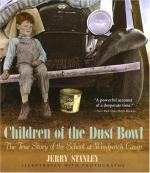
|
| Name: _________________________ | Period: ___________________ |
This test consists of 15 multiple choice questions and 5 short answer questions.
Multiple Choice Questions
1. The starvation diets and unsanitary conditions of the Okie communities led to disease including tuberculosis, pneumonia and what?
(a) Syphillis.
(b) Cholera.
(c) Gangrene.
(d) Dysentery.
2. How far does the Tehachapi Mountain Range extend?
(a) 40 miles.
(b) 50 miles.
(c) 25 miles.
(d) 100 miles.
3. Where did the roads begin climbing into the Black Mountains as the Okies traveled west?
(a) Santa Fe, New Mexico.
(b) Anderson, Arizona.
(c) Kingman, Arizona.
(d) Whitney, California.
4. What danger was in the air created by the wind in the dust storms?
(a) Hail.
(b) Snow.
(c) Chemicals.
(d) Static electricity.
5. From 1930 through 1940, the number of dust bowl farmers declined by how many?
(a) 200,000.
(b) 300,000.
(c) 100,000.
(d) 400,000.
6. What condition was caused by severe damage to the lungs by the inhalation of dust?
(a) Red pneumonia.
(b) Emphesema.
(c) Dust pneumonia.
(d) Tuberculosis.
7. When had the Great Depression begun?
(a) 1925.
(b) 1919.
(c) 1929.
(d) 1932.
8. The farmers of the 1930s in the Oklahoma Panhandle were referred to as what kind of farmers?
(a) Tomato.
(b) Dirt.
(c) Dry.
(d) Wet.
9. What city was the Dust Bowl centered near?
(a) Tuscon, OK.
(b) Hooker, OK.
(c) Beaver, OK.
(d) Goodwell, OK.
10. Many of the squatters in Okie communities lived in shacks made of what?
(a) Tires.
(b) Cardboard.
(c) Clay.
(d) Chicken sheds.
11. The average migrant farmhand during the Dust Bowl period worked how many days per week?
(a) 5.
(b) 7.
(c) 4.
(d) 6.
12. Who wrote The Grapes of Wrath?
(a) F. Scott Fitzgerald.
(b) Alexander Welsh.
(c) John Steinbeck.
(d) Ernest Hemingway.
13. Where was it rumored among the Okies that grape-pickers were needed when they arrived in California?
(a) Bakersfield.
(b) Sonoma.
(c) Eureka.
(d) Sacramento.
14. What division of the Department of Agriculture began the construction of farm-labor camps for the Okies?
(a) The Farm Security Administration.
(b) The Farm Equity Association.
(c) Department of Farm Security.
(d) Department of Alcohol, Tobacco and Firearms.
15. Californians claimed that the Okies were taking what from them during their influx?
(a) Jobs.
(b) Regulations.
(c) Money.
(d) Homes.
Short Answer Questions
1. When there was enough rain, what crops did the Okies in the Panhandle grow?
2. The migrant workers were increasing the state and county costs for what during the Dust Bowl period in California?
3. More than how many Americans were left homeless due to the Dust Bowl?
4. In 1936, the author writes that it had not rained more than a few drops in the Panhandle in how many years?
5. It was said that the farms in California were needing how many farm laborers during the period of the Dust Bowl?
|
This section contains 390 words (approx. 2 pages at 300 words per page) |

|




